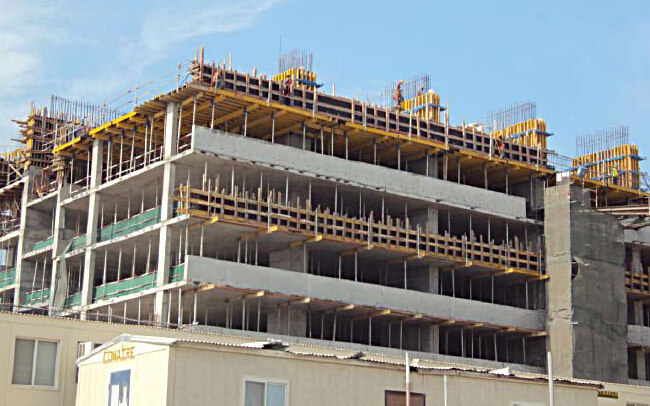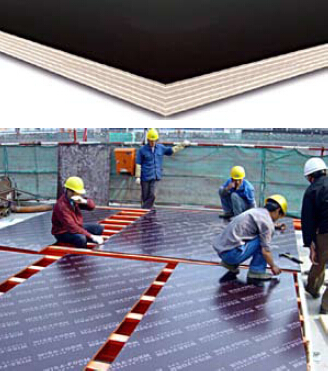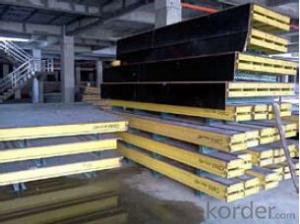Plywood Formwork System for formwork and scaffolding
- Loading Port:
- Tianjin
- Payment Terms:
- TT OR LC
- Min Order Qty:
- 50 m²
- Supply Capability:
- 1000 m²/month
OKorder Service Pledge
Quality Product, Order Online Tracking, Timely Delivery
OKorder Financial Service
Credit Rating, Credit Services, Credit Purchasing
You Might Also Like
Plywood --- make perfect concrete surface
WISA-Form Birch is a coated special plywood using in the formwork systems where high
requirements are set on the concrete surface and the times of reuses.
With CNBM timber beam & WISA plywood, the formwork is low weight but high load capacity, it is
widely used in construction.
Characteristics:
◆ Component with high standardization.
◆ Assembling in site, flexible application.
◆ Light weight, easy transportation and storage.


- Q:Steel formwork in the construction project, after the completion of concrete pouring, the wall surface from the powder seriously how to deal with?
- There is a problem with the ratio of the concrete itself.
- Q:Is steel formwork suitable for projects with high concrete strength requirements?
- Yes, steel formwork is suitable for projects with high concrete strength requirements. Steel formwork is known for its high strength and durability, making it ideal for projects that require high concrete strength. It can withstand the pressure and weight of the concrete, ensuring that it maintains its shape and stability during the pouring and curing process. Additionally, steel formwork provides a smooth and uniform finish to the concrete, which is important for achieving high strength and quality in the final product. Moreover, steel formwork can be easily reused multiple times, making it a cost-effective option for projects with high concrete strength requirements.
- Q:What is the cost of steel formwork compared to other types of formwork?
- The cost of steel formwork is generally higher compared to other types of formwork due to its durability, reusability, and strength. While it may have a higher upfront cost, it provides long-term cost benefits over time as it can be used multiple times and requires minimal maintenance.
- Q:How does steel formwork contribute to the overall structural integrity of the building?
- Steel formwork contributes to the overall structural integrity of a building in several ways. Firstly, steel formwork provides strong and durable support for the concrete during the construction process. The use of steel ensures that the formwork does not deform or collapse under the weight of the concrete, leading to a more stable and secure structure. Additionally, steel formwork allows for precise and accurate shaping of the concrete, ensuring that the building components are constructed to the required dimensions and specifications. This level of precision is essential for maintaining the structural integrity of the building, as any deviations from the intended design can compromise its stability and safety. Furthermore, steel formwork provides excellent resistance to external forces such as wind, earthquakes, and other environmental loads. The inherent strength and rigidity of steel make it highly resistant to deformation, ensuring that the formwork can withstand these forces without compromising the structural integrity of the building. Moreover, steel formwork is resistant to moisture and other corrosive elements, which can significantly impact the durability and longevity of the structure. By using steel formwork, the risk of deterioration and structural damage due to moisture, rust, or other corrosive agents is minimized, thereby enhancing the overall structural integrity of the building. Lastly, steel formwork allows for efficient construction processes, reducing the time and labor required for building construction. This efficiency not only ensures cost-effectiveness but also minimizes the potential for errors and defects during the construction, thereby further enhancing the structural integrity of the building. In conclusion, steel formwork plays a crucial role in contributing to the overall structural integrity of a building. Its strength, durability, precision, resistance to external forces and corrosion, as well as its contribution to efficient construction processes, all combine to ensure a safe, stable, and long-lasting structure.
- Q:What are the safety considerations when using steel formwork?
- When using steel formwork, there are several safety considerations that need to be taken into account. Firstly, it is important to ensure that the formwork is properly installed and secured to prevent any collapses or accidents. Regular inspections should be conducted to check for any signs of wear or damage that could compromise its stability. Another safety consideration is the proper handling and storage of steel formwork. It can be heavy and cumbersome, so workers should be trained in proper lifting techniques to avoid strains or injuries. Adequate storage facilities should be provided to prevent any damage or tripping hazards. Additionally, when working with steel formwork, workers should wear appropriate personal protective equipment (PPE) such as helmets, gloves, and safety boots to protect themselves from any potential hazards or falling debris. They should also be trained in safe work practices, including proper use of tools and equipment, as well as the correct procedures for dismantling the formwork after use. Overall, by following these safety considerations, the risks associated with using steel formwork can be minimized, ensuring a safe working environment for all involved.
- Q:What are the considerations when designing steel formwork for architectural sculptures?
- When designing steel formwork for architectural sculptures, there are several important considerations that need to be taken into account. Firstly, the structural integrity and stability of the formwork is paramount. The formwork must be able to withstand the weight of the concrete or other materials that will be poured into it, as well as any external forces that may be applied during the construction process. This requires careful analysis and engineering to ensure that the formwork is strong enough to support the weight and forces without any risk of collapse. Secondly, the accuracy and precision of the formwork is crucial. Architectural sculptures often require intricate and detailed designs, so the formwork must be able to accurately reproduce these shapes. This may involve using advanced computer-aided design (CAD) software to create precise 3D models of the sculpture, which can then be used to fabricate the formwork. Another consideration is the ease of assembly and disassembly of the formwork. Architectural sculptures can be complex and intricate, so the formwork must be designed in a way that allows for easy assembly and disassembly. This may involve using modular components that can be easily connected and disconnected, as well as incorporating features such as adjustable supports or brackets to accommodate different shapes and sizes. Additionally, the choice of materials for the formwork is important. Steel is a common choice due to its strength and durability, but other materials such as aluminum or fiberglass may also be used depending on the specific requirements of the project. The materials used must be able to withstand the weight and forces applied during construction, as well as any potential exposure to weather or other environmental conditions. Finally, considerations should be made for the aesthetics of the formwork. While the primary function of the formwork is to support the construction process, it is also important that it does not detract from the overall visual impact of the sculpture. This may involve using smooth finishes, hidden connections, or other design techniques to ensure that the formwork remains visually appealing. In conclusion, designing steel formwork for architectural sculptures requires careful consideration of factors such as structural integrity, accuracy, ease of assembly, material selection, and aesthetics. By addressing these considerations, designers can ensure that the formwork is not only functional and safe but also enhances the overall artistic vision of the sculpture.
- Q:How does steel formwork contribute to the overall safety of workers?
- Steel formwork contributes to the overall safety of workers in several ways. Firstly, steel formwork is known for its strength and durability, providing a stable and secure structure for workers to perform their tasks. This stability minimizes the risk of accidents and collapses, ensuring the safety of workers. Additionally, steel formwork is designed to be fire-resistant, offering protection in case of fire emergencies. This feature significantly reduces the risk of injuries and provides workers with valuable time to evacuate the area safely. Moreover, steel formwork is engineered to be resistant to various weather conditions, such as strong winds and heavy rains. This resistance prevents formwork from becoming unstable or collapsing during adverse weather, minimizing the risk of accidents and injuries for workers on-site. Furthermore, steel formwork is typically designed with safety features such as non-slip surfaces and handrails, enhancing worker safety by providing better grip and stability when moving around the structure. These features help prevent slips, trips, and falls, which are common causes of accidents on construction sites. Another important aspect is that steel formwork is reusable and can be easily assembled and disassembled. This reduces the need for workers to carry heavy materials or tools, decreasing the risk of strain injuries and fatigue-related accidents. Lastly, steel formwork is designed to ensure proper support and alignment, minimizing the risk of structural failures or collapses during concrete pouring. This precise alignment ensures the stability of the structure and reduces the likelihood of accidents that could endanger workers' safety. In conclusion, steel formwork plays a crucial role in enhancing the overall safety of workers. Its strength, durability, fire resistance, weather resistance, non-slip surfaces, and proper support contribute significantly to creating a secure working environment, reducing the risk of accidents, injuries, and structural failures.
- Q:Can steel formwork be used for architectural concrete walls with complex geometries?
- Yes, steel formwork can be used for architectural concrete walls with complex geometries. Steel formwork offers several advantages for such applications. It is highly durable and can withstand the pressure exerted by the concrete during pouring and curing. Steel formwork also provides excellent dimensional accuracy, ensuring that the concrete walls are built according to the desired complex geometries. Moreover, steel formwork allows for easy customization and flexibility in design. It can be easily fabricated into various shapes and sizes, enabling architects to create intricate and unique architectural concrete walls. Steel formwork also offers a smooth and uniform finish to the concrete, resulting in aesthetically pleasing walls. Additionally, steel formwork is reusable, making it a cost-effective choice for projects with complex geometries. It can be dismantled and used for multiple projects, reducing the overall construction costs. Steel formwork is also easy to clean and maintain, further enhancing its usability and longevity. In conclusion, steel formwork is an ideal choice for architectural concrete walls with complex geometries. It provides strength, durability, dimensional accuracy, customization options, and cost-effectiveness, making it a suitable solution for constructing visually appealing and structurally sound concrete walls.
- Q:How does steel formwork affect the overall safety of a construction project?
- Steel formwork can significantly improve the overall safety of a construction project. Due to its high strength and durability, steel formwork provides a stable and rigid structure that can withstand heavy loads and adverse weather conditions. This reduces the risk of formwork collapse or failure, ensuring the safety of workers and preventing potential accidents. Additionally, steel formwork offers enhanced fire resistance, minimizing the spread of fires on construction sites and further enhancing safety measures. Overall, the use of steel formwork enhances the safety standards of a construction project, providing a reliable and secure framework for successful completion.
- Q:What are the advantages and disadvantages of the application of the steel formwork and the plywood formwork in the construction?
- According to the area of the project, such as the number of layers to determine the type of templateFrom the perspective of saving wood, the state generally encourage the use of steel formwork
1. Manufacturer Overview |
|
|---|---|
| Location | |
| Year Established | |
| Annual Output Value | |
| Main Markets | |
| Company Certifications | |
2. Manufacturer Certificates |
|
|---|---|
| a) Certification Name | |
| Range | |
| Reference | |
| Validity Period | |
3. Manufacturer Capability |
|
|---|---|
| a)Trade Capacity | |
| Nearest Port | |
| Export Percentage | |
| No.of Employees in Trade Department | |
| Language Spoken: | |
| b)Factory Information | |
| Factory Size: | |
| No. of Production Lines | |
| Contract Manufacturing | |
| Product Price Range | |
Send your message to us
Plywood Formwork System for formwork and scaffolding
- Loading Port:
- Tianjin
- Payment Terms:
- TT OR LC
- Min Order Qty:
- 50 m²
- Supply Capability:
- 1000 m²/month
OKorder Service Pledge
Quality Product, Order Online Tracking, Timely Delivery
OKorder Financial Service
Credit Rating, Credit Services, Credit Purchasing
Similar products
New products
Hot products
Related keywords
























